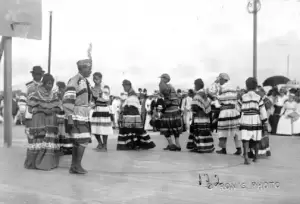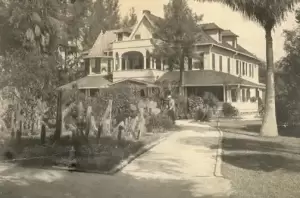Fun and Games Becomes Culture

When the Majewski family arrived in 1895, they opened the first ice cream parlor in West Palm Beach, a center of social activity, said daughter Mary: “There were three young men at the time that used to come by nightly … and play the mandolin and guitar and sing and draw a crowd, of course. And they knew always, of course, that they were going to end up with a pretty good-sized dish of ice cream.”
A local optician and jeweler, Frank Idner, also drew crowds to his weekly “concerts” in City Park, where he shared his gramophone (a phonograph, the first machine to play disc recordings).
Friday night dances were held at the Fire Hall on the corner of Dixie and Datura, and sometimes “practice dances” on weeknights with a gramophone. The weekend music was played by an African American nicknamed Rabbit, said Mary Majewski Brewer: “He wasn’t any bigger than a cake of soap after a hard day’s washing. I think he played entirely by ear. And you really had to dance when Rabbit set down at the piano and started to play because it was that type of music.”
Early community celebrations always included the Fourth of July. About 1902, teenager Clarence Whipple convinced West Palm Beach Mayor George Currie to put him in charge of the program:
That whole celebration only cost $112.00. And that was derived from advertisements that I secured. … I gave $35.00 for the best decorated automobile, and … I had potato races and three-legged races and foot races and sack races, all around $5 and $10 for the prizes.
The bicycle race was the main feature in them days. We had quite a crowd when we had a bicycle race, standing on the corners filled with people. Five miles going as hard as you can is pretty good. The streets were paved at that time.Clarence Whipple

A much larger event started in 1916, when for three days each March, the Seminole Sun Dance was celebrated in West Palm Beach, forerunner of today’s Sun Fest. Songwriter, mayor, and developer George Currie wrote lyrics for the occasion, which said in part: “First natives are we of fair Florida land … Our maids kept its tepees and kindled its flame.” But the Seminoles were neither Florida’s first natives, nor did they live in tepees. They did participate in the event, however, as recalled by Thomas Tipton “T. T.” Reese, Jr.:
They’d import a whole Indian village—Sammie Tommie and Billy Bowlegs and one of the Indian tribes would come—[it’d] be a couple a hundred Indians. Everything would stop almost to a standstill for a week. And everybody’d dress up in Indian costume and they’d have street dances in the middle of Clematis Avenue. They had Ringling Brothers and Barnum and Bailey’s combined circus. They’d have regular Indian dancing, but there’d be street dancing and everybody in costume. And fellows like Paul Clarke would have a rattlesnake pit, y’know, and a little gas-burning stove, and you’d get a rattlesnake sandwich for a dime.
Thomas Tipton “T. T.” Reese, Jr.

Carl Kettler, Jr. opened the first theater, the Bijou, in 1908 in the Jefferson Building on Clematis. The opening feature was The Great Train Robbery. Kettler, whose father was private secretary to actor-entrepreneur Joseph Jefferson, had also acted with Jefferson as a child.
The Fortnightly Club
On the east side of the lake, winter residents enjoyed high-brow fare at the Fortnightly Club, which began as a literary club in 1901 at the home of Frederick and Marsena Nelson Robert, Fleur d’Eau, (Water Flower) on Lake Trail. Mrs. Robert was praised for arranging a far-reaching array of programming until 1908, when her retirement ended the club. Mrs. Robert and Mrs. Henry Flagler as vocalists, and Belle Dimick (then Mrs. T. T. Reese) on organ were among the musical performers; others gave readings. The venues varied, from the Flagler home, Whitehall, to the Cragin’s “Dream of Summer,” Reve d’Été, to a Breakers cottage. The membership offered even more diversity, including women from the earliest pioneers to wealthy socialites who spent their summers in northern cities. Several men were honorary members, such as the local pastors, and actor Joseph Jefferson.


